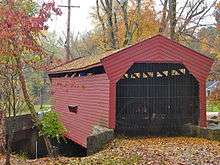Bartram's Covered Bridge
|
Bartram's Covered Bridge | |
|
Bartram's Covered Bridge, October 2009 | |
  | |
| Location | West of Newtown on Legislative Route 15098, Newtown, Pennsylvania |
|---|---|
| Coordinates | 39°59′23″N 75°26′15″W / 39.98972°N 75.43750°WCoordinates: 39°59′23″N 75°26′15″W / 39.98972°N 75.43750°W |
| Area | less than one acre |
| Built | 1860 |
| Built by | Wood,Ferdinand |
| Architectural style | Other, Burr truss |
| MPS | Covered Bridges of Chester County TR |
| NRHP Reference # | 80003462[1] |
| Added to NRHP | December 10, 1980 |
Bartram's Covered Bridge, a historic covered bridge built in 1860, uses a Burr Truss design and carried Goshen Road over Crum Creek on the border between Delaware County and Chester County, Pennsylvania. It is 30 feet (9.1 m) long and 13 feet (4.0 m) wide and is the only covered bridge remaining of the 30 which once stood in Delaware County. The bridge has slanted planks at each entrance and is the only covered bridge in Pennsylvania with this feature. According to an on-site marker from the Newtown Square Historical Preservation Society, the bridge was built to be "hi and wide as a load of hay"[2] It was built by Ferdinand Wood and named for Mordecai Bartram.[3]
It was closed to traffic in 1941 and stands next to a new bridge on Goshen Road. The east end of the bridge is located in Newtown Township, Delaware County and the west end in Willistown Township, Chester County.[4][5]
It was listed on the National Register of Historic Places in 1980.
Economic impact

This bridge was extremely economical to build because the cost was shared between two townships, the material was cheap, and construction was quick. The choice of wood was wise given the time and the cost of the material. The region still has abundant trees, including many hardwoods such as beech trees which further lowered costs, since the materials were local. The bridge was constructed in 1860 when most structures were made from either wood or stone. Wood is by far the cheaper of the materials, and when joined correctly, it can hold tensile forces. Since wood can support tension and bending loads, the bridge could be built at the level of the banks, instead of building a stone arch beneath the deck of the bridge. Additionally, it is much faster to construct a wooden structure than a stone one. Overall, the bridge cost just $1,133 and to date, has only been repaired a few times. The economic impact was not just immediate; currently, the bridge is a historic landmark and helps fund the Historical Society of Newtown Square.
Efficiency

Bartram’s bridge is an efficient solution to the many streams that cross the region. It was created “Hi and Wide as a Load of Hay”[2] to serve the needs at the time which were mainly agricultural. Its size allowed it to continue to be used until 1941, when it was closed to the public. The choice of the extremely efficient Burr Truss allowed the bridge to have outstanding stiffness and stability with both live and dead loads. The bridge had to hold its own gravity load, the live loads of the horses and the carriages, and any wind loads. The gravity load is easily supported by the arch alone, and the combination of the arch and truss give exceptional stiffness for the live loads. Combination of the truss and arch also allows more of the members to remain in compression which uses the joints to their full effectiveness.
Elegance
The bridge is also an elegant solution. By combining the two forms of arch and truss, the resulting structure is much stronger than either form alone. An arch is relatively weak with live loads, and the truss holds most of the live loads the bridge faced. The structure is mostly indicative of the load path when on the inside, and the interior is clear and flat. A unique feature of the bridge is its windows. They are an opening of the covering in the middle of the bridge, each with its own small roof. The windows only appear to exist in order to promote air flow, not to give a view of the beautiful creek that flows beneath it. Additionally, on the entrances of the bridge, the slats are slanted to line up with the roof instead of with the ground. This is both aesthetically pleasing and helps direct the water from the interior of the bridge.
See also
| Wikimedia Commons has media related to Bartram's Covered Bridge. |
- List of covered Covered bridges on the National Register of Historic Places in Pennsylvania
References
- ↑ National Park Service (2010-07-09). "National Register Information System". National Register of Historic Places. National Park Service.
- 1 2 Bartram's Covered Bridge, On the Newtown Square Historical Society's website.
- ↑ See Driscoll (2011), Introduction
- ↑ Zacher, Susan M. (1994). The Covered Bridges of Pennsylvania: A Guide. Harrisburg: Pennsylvania Historical and Museum Commission. p. 134.
- ↑ "National Historic Landmarks & National Register of Historic Places in Pennsylvania" (Searchable database). CRGIS: Cultural Resources Geographic Information System. Note: This includes Susan M. Zacher (July 1980). "National Register of Historic Places Inventory Nomination Form: Covered Bridges of Chester County TR, Bartram's Covered Bridge" (PDF). Retrieved 2012-01-02.
Sources
- Driscoll, Christopher P.; Conn, George D.; Humes, Doug P.; Gerst, Eric D. (2011). Bartram Covered Bridge: Spanning History. eBookIt.com and The Newtown Square Historical Preservation Society. p. 118.

